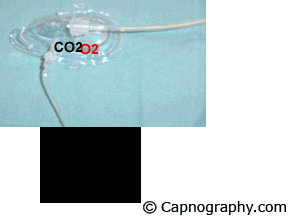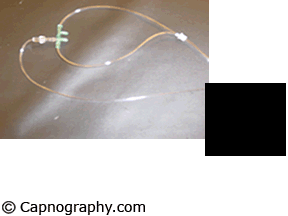ASA Standards of monitoring during anesthesia
Adequacy of spontaneous respiration
| Sampling of CO2 from oxygen mask | Sampling of CO2 from nasal cannulae |
 |
 |
Capnography can be used to monitor the adequacy of spontaneous ventilation, not only during general anesthesia and recovery but also in the awake unintubated patient either in the intensive care unit or during regional anesthesia. In addition, C02 monitoring can serve as an apnea monitor. The samples can be drawn from the nasal cavity using nasal adaptors or cannulae.1-4 Gases can also be sampled from the nasal cavity during the administration of oxygen using a simple modification of the standard nasal cannulae. End-tidal C02 tension, thus measured, is a good predictor of PaC02 even when oxygen is being administered simultaneously.2,4 This may be of particular benefit in monitoring the ventilatory status of patients with chronic respiratory failure where excessive oxygen therapy can produce C02 narcosis. However, the major limiting factor is the admixture of end-tidal gas with air or insufflated oxygen resulting in a falsely low PETCO2 particularly in mouth breathing patients, or in those who may require more than 4 1. min-l of nasal oxygen, or in patients who are hypoventilating.2,4

 Twitter
Twitter Youtube
Youtube









